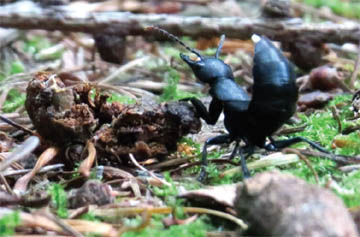| Wildlife
Newsletter for the Township of Dalkey November / 2016 - Michael Ryan |
||
|
|
|
‘I
have a very handy suggestion when it comes to deterring squirrels from
bird feeders. If you get hold of some hot chilli powder in the supermarket
(make sure it is just pure chilli powder, with no salt or other ingredients
added) and dust peanuts, seed, etc. with it before putting them in the
feeders, it can be very effective. The chemical in chilli which causes
the burning sensation in the mouth only works on mammals, including
squirrels, rats and mice (and, of course, humans). Birds are unable
to taste it, and it has no effect on them whatsoever. If a squirrel
tries to eat the food, it gets a very unpleasant surprise, though no
harm is caused to it: the pain caused
by chilli is due to pain receptors being tricked, not actual physical
damage. They pretty quickly learn to avoid the offending feeders, while
the birds are none the wiser.’ |
| Usually
in the grove of pines where we saw the female squirrel I’d be keeping
my eyes trained upwards to the treetops so it was lucky I spotted a beetle
on the ground before I stepped on it. It moved with the rear of its long
body curved upward like a tiny scorpion, shiny black apart from two tiny
white tips at the end of its abdomen which on closer inspection turned
out to be two tiny pincers. Afraid that somebody, probably me, would step
on it I tried to move it somewhere safer. I attempted to get it to climb
on to a leaf then held my hand down flat so it could climb on but it refused
my entreaties and eventually dug down under some leaves and twigs, moving
a fallen pine cone in the process which I thought quite impressive for
a tiny creature. I had my suspicions what it was and sure enough on subsequently
checking I found it was the dramatically named Devil’s Coach Horse
Beetle (Ocypus olens). They are ‘voracious predators active at night,
when they consume small slugs and snails, and a wide range of other invertebrates’.
I also read that the scorpion’s pose was a defensive action and
when threatened it can emit a foul smelling odour from the two white pincers
as well as inflict a nasty bite so I was glad it had ignored my hands-on
approach. This beetle has been associated with the Devil since the Middle
Ages, hence its common name. Other names include Devil’s Footman
or Devil’s Steed. |
 Devil’s Coach Horse beetle Photo: Michael Ryan |
| In Ireland the beetle is known as darbhadal (literally Devil’s Beast) and it is said that the Devil assumes the form of this beetle to eat sinners! Seasonal anomalies have become so normal it would be almost surprising if we didn’t have reports of unseasonal spectacularly early or late plant flowerings or insects and other creatures emerging early. On Dalkey Hill there were wild Cranesbill flowering in mid- October while on a Mountain Ash (Rowan) tree there were wilted dying leaves on one stem while new bright green leaves had recently appeared on a lower stem. In the garden there were new flowers opening at the same time as the berries ripened on the hypericum and berberis. In the office car park the Pyracantha bush, resplendent with a mass of orange berries, also had a little bloom of white flowers emerging, at least six months earlier than normal. Ireland has two native species of oak, the Common or Pendunculate Oak and the Sessile Oak both of which grow on Dalkey and Killiney Hills. It would be an exaggeration to say the woodland floor on Killiney Hill was carpeted by fallen acorns in early October but there was certainly a spectacular amount of them lying on the ground, denoting a bumper seed or ‘mast’ year for oaks. Apart from seasonal climatic factors, different species of trees have natural cycles of seed production so a certain number of years will pass with average or poor seed production before one year will produce a very heavy or mast crop and it certainly looks like this is going to be one of those years for oaks. The oak’s mast years are usually every three to five years when apparently a mature tree can produce up to 50,000 acorns although most of the early falling small green acorns won’t produce seed, it’s only the later brown woodier acorns that have the potential to grow into new trees . The oak is one of the last trees to lose its leaves in the autumn and the theory is when the leaves drop they will cover the already fallen acorns protecting them from frost and seed eating animals and birds. One of those seed eating birds which has become a very welcome presence around the hills is the jay, always associated with oak woods and we heard one’s raucous call then saw it foraging for acorns high up near the crown of a oak. Jays will store caches of acorns for later in the winter either stashing them in tree trunks or burying them and they are credited with helping oak woods spread since acorns don’t fall far from the parent tree but uneaten acorns the jays may have buried some distance away will often germinate. |
DALKEY HOME PAGE | DALKEY COMMUNITY COUNCIL | DALKEY HERITAGE COMPANY | CANNONAID